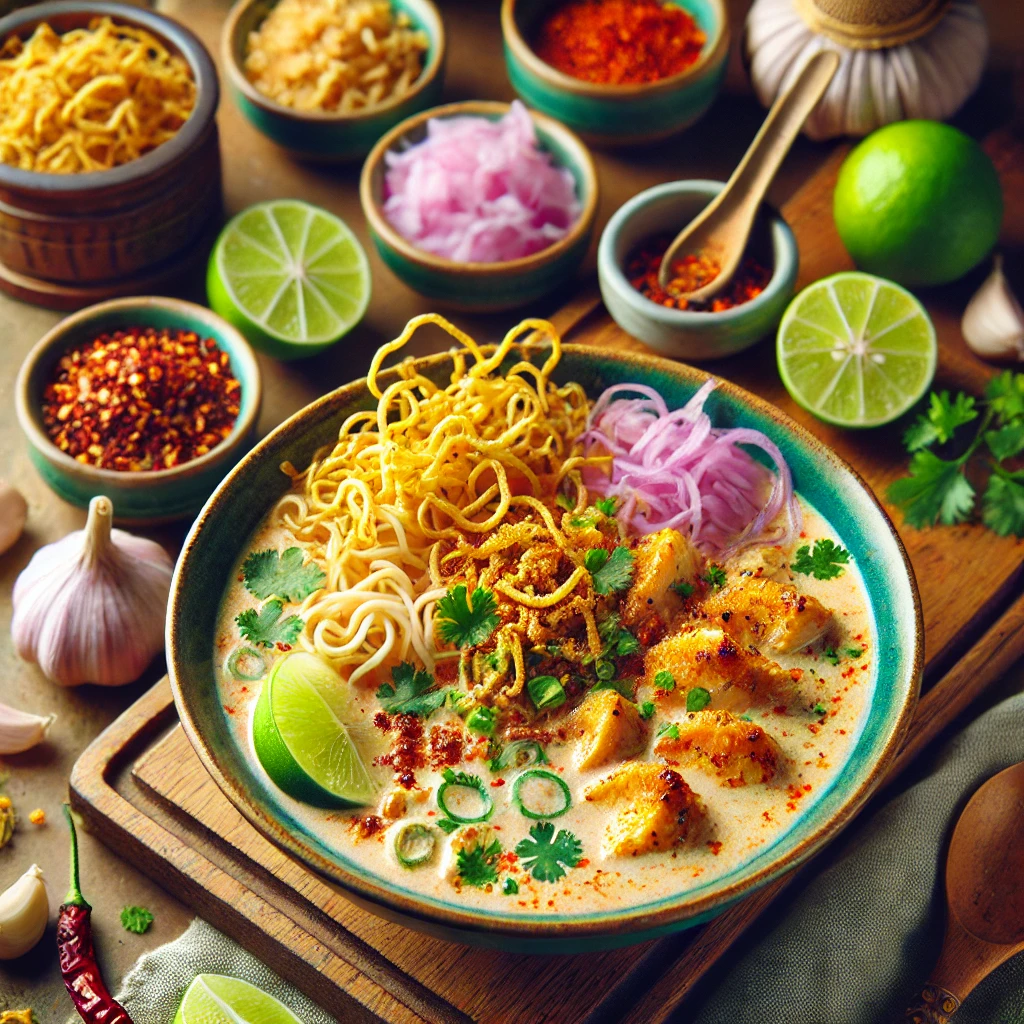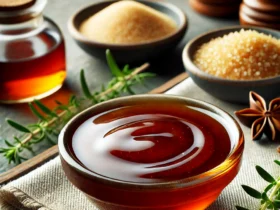Introduction
Khow Suey is a traditional Burmese dish that has gained popularity in various parts of the world, particularly in South Asia. This dish is a delightful fusion of noodles, coconut milk, and a variety of flavorful toppings, offering a rich and satisfying culinary experience. It is known for its creamy texture, aromatic spices, and the vibrant array of condiments that allow for customization according to individual tastes.
Origin and Cultural Significance
Khow Suey, also known as Khao Suey or Khao Soi, originates from Myanmar (Burma). It is a staple in Burmese cuisine and has been influenced by neighboring countries like Thailand and India. The dish reflects the diverse culinary traditions of the region, blending elements of Burmese, Thai, and Indian cooking. It is often enjoyed as a comfort food and is served during family gatherings and festive occasions.
Ingredients
The essential ingredients of Khow Suey include:
- Noodles: Typically, egg noodles are used, but rice noodles can also be a substitute.
- Coconut Milk: This forms the base of the broth, giving it a creamy and rich texture.
- Protein: Chicken, beef, or shrimp are commonly used, though vegetarian versions with tofu or vegetables are also popular.
- Spices: A combination of spices, including turmeric, cumin, coriander, and chili powder, adds depth and warmth to the dish.
- Toppings and Garnishes: Khow Suey is known for its wide range of condiments, including crispy fried noodles, garlic, onions, lime wedges, boiled eggs, fresh coriander, chili flakes, and fried shallots.
Preparation
Preparing Khow Suey involves several steps, each contributing to the dish’s complex flavor profile:
- Noodle Preparation: Noodles are boiled until tender and set aside.
- Cooking the Broth: The broth is made by sautéing onions, garlic, and ginger in oil, followed by adding spices and coconut milk. The chosen protein is then cooked in this flavorful mixture.
- Assembling the Dish: Cooked noodles are placed in a bowl, and the rich coconut broth with protein is poured over them.
- Adding Toppings: The dish is finished with a variety of toppings, allowing diners to customize their bowls according to their preferences.
Nutritional Value
Khow Suey is a nutrient-rich dish, offering a balance of carbohydrates, proteins, and fats. The coconut milk provides healthy fats, while the noodles and protein add energy and sustenance. The array of toppings, including fresh herbs and vegetables, enhances the dish’s nutritional profile with vitamins and minerals.
Variations
Khow Suey is a versatile dish with numerous regional and personal variations:
- Thai Khao Soi: A version popular in Northern Thailand, often spicier and served with pickled mustard greens and lime.
- Vegetarian Khow Suey: Made with tofu, mushrooms, and a variety of vegetables, catering to vegetarian and vegan diets.
- Seafood Khow Suey: Includes seafood like shrimp or fish, adding a different dimension of flavor.
Conclusion
Khow Suey is a testament to the rich culinary heritage of Burma and its neighboring regions. Its combination of creamy coconut milk, flavorful spices, and diverse toppings makes it a beloved dish worldwide. Whether enjoyed as a hearty meal or a comfort food, Khow Suey offers a unique and satisfying experience for the palate.
Khow Suey FAQ
1. What is Khow Suey?
Khow Suey is a traditional Burmese dish that consists of noodles served in a rich coconut milk broth, topped with a variety of condiments and garnishes. It is known for its creamy texture and flavorful spices.
2. What are the main ingredients in Khow Suey?
The main ingredients include noodles (typically egg noodles), coconut milk, protein (such as chicken, beef, shrimp, or tofu), and a mix of spices like turmeric, cumin, and coriander. The dish is garnished with toppings such as crispy fried noodles, garlic, onions, lime wedges, and fresh coriander.
3. Is Khow Suey spicy?
The level of spiciness in Khow Suey can vary. It generally has a mild to moderate heat level, depending on the amount of chili powder and other spices used. The dish can be made spicier with additional chili flakes or less spicy by reducing the chili content.
4. Can Khow Suey be made vegetarian or vegan?
Yes, Khow Suey can be easily adapted to vegetarian or vegan diets. For a vegetarian version, you can use tofu or vegetables as the protein source. To make it vegan, ensure that the noodles and other ingredients do not contain animal products.
5. How is Khow Suey typically served?
Khow Suey is served in a bowl with noodles at the bottom, topped with the coconut milk broth and protein. It is garnished with a variety of toppings, such as crispy noodles, garlic, onions, and fresh herbs. Lime wedges are often provided on the side for an added burst of freshness.
6. What are some popular variations of Khow Suey?
Popular variations include:
- Thai Khao Soi: A spicier version with additional toppings like pickled mustard greens.
- Seafood Khow Suey: Made with shrimp, fish, or other seafood.
- Vegetarian Khow Suey: Includes tofu or vegetables in place of meat.
7. Is Khow Suey gluten-free?
Khow Suey can be made gluten-free by using gluten-free noodles and ensuring that all other ingredients, including soy sauce and other condiments, are gluten-free.
8. Can I prepare Khow Suey in advance?
The components of Khow Suey, such as the broth and toppings, can be prepared in advance and stored separately. Assemble the dish just before serving to ensure the noodles do not become soggy and the toppings retain their texture.
9. What should I do if my Khow Suey is too thick or too thin?
If the broth is too thick, you can thin it out by adding more coconut milk or water. If it is too thin, simmer it longer to reduce the liquid or add a bit more coconut milk or a thickening agent like cornstarch mixed with water.
10. What are some good side dishes to serve with Khow Suey?
Khow Suey is often served as a standalone dish, but it can be complemented with side dishes like fresh salads, spring rolls, or steamed vegetables to add more variety to the meal.







Leave a Reply